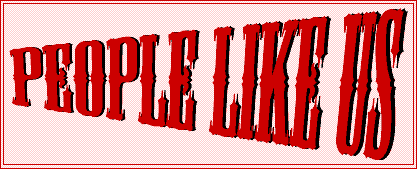
by Oren the Otter
©2000 Oren the Otter -- all rights reserved

by Oren the Otter
©2000 Oren the Otter -- all rights reserved
| Oren: | Hello, and welcome once again to "People Like Us"! Today's guest is Kevin & Kell author Bill Holbrook. Bill, glad to have you here with us! |
| Bill: | Sure thing. The pleasure is mine! |

| Oren: | Bill, would you tell us a little bit about your comic strip, please? |
| Bill: | Certainly!
The word "dysfunctional" has attached itself to the word "relationship" like a mastiff sinking its teeth into a small quadruped. This has created a hunger for a household that works, that comes together despite its differences, that draws strength from each member's love, support -- and ability to groom for parasites. Kevin & Kell is pointed to a family audience, teens and adults alike. It follows the adventures of two very different individuals who have fallen in love: Kevin, a burly rabbit, and Kell, a petite she-wolf. The resulting clash with their disapproving society provides satiric comedy in which in the issues of our world are played out and resolved. One aspect of this world, of course, is that beyond the family unit carnivores do eat herbivores. For the Dewclaws, the issue of predator and prey are utilized in a benign, humorous fashion, depicting daily life with slightly raised stakes. Kevin and Kell live in a hollow tree (at the corner of Tooth and Nail Streets) containing all the comforts of a suburban home: TV, indoor plumbing and neighbors with binoculars. In this woodland setting the basic antagonism between herbivores and carnivores provides a prism through which the divisions of modern living are depicted. The two individuals find themselves arrayed against various entities that are threatened by such an unconventional coupling: a government that doesn't know how to classify them, corporations that turn down promotions, relatives who reject them, businesses that discriminate and refuse service and a community that barely tolerates tolerance. Kevin and Kell are confronted with forces that seek to divide them, but they persevere through their commitment to one another. This is a family that is riven by internal contradictions, with each member having a built-in conflict with the other four. Yet whatever problems arise for the Dewclaws, our rabbit and wolf never waver in the things that are truly important -- their mutual well-being, the future of their children, the happiness they provide... and everything else between Kevin & Kell. |
| Oren: | Now correct me if I'm wrong, but didn't I once hear you say that the "furry" aspect of Kevin & Kell was an idea spawned by events within your other two strips, On the Fast Track and Safe Havens. |
| Bill: | In a way, yes. In both strips I frequently have the characters turn into animals (or objects) to illustrate a point. For example, in Fast Track, when Art Welding was put in charge of preventing employee abuse of the Internet, he's transformed into a fox guarding a henhouse. Just the other day I did a Sunday strip (appearing in March) in which Bud Spore becomes a raccoon opening a garbage can and rooting through its contents. It turns out he's looking for some lost data in the system's Trash file.
My main reason for doing a strip with animals, however, was to be able to comment on the union of opposites in a way that was universal. With a human cast, any difference of race, religion, class, etc, would have been too specific. The rabbit/wolf context enables the strip to pertain to any distinction that creates mistrust. Kevin and Kell can then transcend that divide, in a way that a wider audience can relate to. |
| Oren: | So if Kevin and Kell represent any two given members of the human
race, what about the birds? Are they representative of aliens
who are running the world in real life? And are you in fact in
league with these aliens? Huh? C'mon, you can tell me!
Ah yes! I see it now! You're actually part of a secret society of cartoonists who are in league with the plasmoids from the Quincunx system who are planning to relocate the entire human race into different species! No? Oh. Well then... I'd like to ask you about your drawing style. I'm guessing from looking at your work that Watterson must have had some influence on you. As Charles Schulz would say, "It's fun to look at." Your panels are light, detailed, but not weighted down. Your lines are clean, and your dialogue is expressive, but snappy. Not to sound fawning, but Kevin & Kell is to certain Internet strips as chicken soup is to ten-alarm chili. It doesn't need to be endured to be enjoyed. Are there any other artists to whom you credit an influence on the formation of your unique style? |
| Bill: | While I'm a tremendous admirer of Watterson, I can't really say that he influenced my drawing style which was already formed by the time Calvin & Hobbes debuted in 1985. His impact on my work was in the writing, with its shifts of perspective between fantasy and reality.
My major drawing influences were the Mad Magazine artists, primarily Jack Davis and Mort Drucker. Put them together, throw in a little Charles Schulz, a dash of Will Eisner and you get me. |
| Oren: | If I may get just a little nosy, what are your future plans for Kevin & Kell? |
| Bill: | Just to keep the strip funny, and for the characters to continue to develop and grow. |
Thanks so much for coming, Bill! And folks, be sure to check out our guest artist's work in the featured artist section, and more at the Kevin & Kell website. Until then, I'm Oren Otter... except when I turn into something else.
